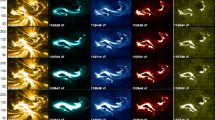Abstract
The emission from the Crab nebula exhibits a significant gamma-ray variability. In this paper we have analyzed this variability in terms of periodicity. Using the pulsar ephemeris constructed from radio data, we have obtained the light curve of the Crab nebula with the suppressed contribution of the pulsar in the energy range 100–300 MeV from August 2008 to March 2020. Using analysis of variance, we have found evidence for a periodicity of flares in the nebula with a period of 49 weeks. The statistical significance of the signal is 0.02 \((2.1\sigma)\) if only the highest peak in the periodogram is taken into account and 0.003 \((2.7\sigma)\) if two peaks, the highest one and the peak at twice the period (98 weeks) that can be caused by the same signal, are taken into account. If the periodicity found is real, then one should expect new periods of enhanced activity of the nebula in August 2021 and 2022.







Similar content being viewed by others
Notes
We will arbitrarily call them ‘‘harmonics.’’
REFERENCES
A. Abdo, M. Ackermann, M. Ajello, A. Allafort, L. Baldini, J. Ballet, et al., Science (Washington, DC, U. S.) 331 (6018), 739 (2011).
S. Abdollahi, F. Acero, M. Ackermann, M. Ajello, W. Atwood, M. Axelsson, et al., Astrophys. J. Suppl. Ser. 247, 33 (2020).
R. Buehler, J. Scargle, R. Blandford, L. Baldini, M. Baring, A. Belfiore, et al., Astrophys. J. 749, 26 (2012).
N. Camus, S. Komissarov, N. Bucciantini, and P. Hughes, Mon. Not. R. Astron. Soc. 400, 1241 (2009).
S. Connolly, arXiv:1305.0304 (2015).
J. Devor, Astrophys. J. 628, 411 (2005).
D. Emmanoulopoulos, I. McHardy, and I. Papadakis, Mon. Not. R. Astron. Soc. 433, 907 (2013).
G. Foster, Astron. J. 112, 1709 (1996).
F. Frescura, C. Engelbrecht, and B. Frank, Mon. Not. R. Astron. Soc. 388 (4), 1693 (2008).
J. Hartman and G. Bakos, Astron. Comput. 17, 1 (2016).
N. Lomb, Astrophys. Space Sci. 39, 447 (1976).
A. Lyne, R. Pritchard, and F. Graham Smith, Mon. Not. R. Astron. Soc. 265, 1003 (1993).
O. Porth, S. Komissarov, and R. Keppens, Mon. Not. R. Astron. Soc. 438, 278 (2014).
M. Pshirkov, B. Nizamov, A. Bykov, and Y. Uvarov, Mon. Not. R. Astron. Soc. 496, 5227 (2020).
J. Scargle, Astrophys. J. 263, 835 (1982).
A. Schwarzenberg-Czerny, Mon. Not. R. Astron. Soc. 241, 153 (1989).
M. Tavani, A. Bulgarelli, V. Vittorini, A. Pellizzoni, E. Striani, P. Caraveo, et al., Science (Washington, DC, U. S.) 331 (6018), 736 (2011).
C. Wilson-Hodge, M. Cherry, G. Case, W. Baumgartner, E. Beklen, P. Narayana Bhat, et al., Astrophys. J. Lett. 727, L40 (2011).
ACKNOWLEDGMENTS
This study was supported by the Ministry of Education and Science of the Russian Federation within the Funding Program of Large Scientific Projects of the ‘‘Science’’ National Project (grant no. 075-15-2020-778). We thank the ‘‘BAZIS’’ Foundation for the Development of Theoretical Physics and Mathematics for its support. The data were processed on the computational cluster of the Department of Theoretical Physics at the Institute for Nuclear Research of the Russian Academy of Sciences.
Author information
Authors and Affiliations
Corresponding author
Additional information
Translated by V. Astakhov
Rights and permissions
About this article
Cite this article
Nizamov, B.A., Pshirkov, M.S. Search for a Periodic Signal in the Emission from the Crab Nebula at High Energies. Astron. Lett. 47, 88–93 (2021). https://doi.org/10.1134/S1063773721020043
Received:
Revised:
Accepted:
Published:
Issue Date:
DOI: https://doi.org/10.1134/S1063773721020043




